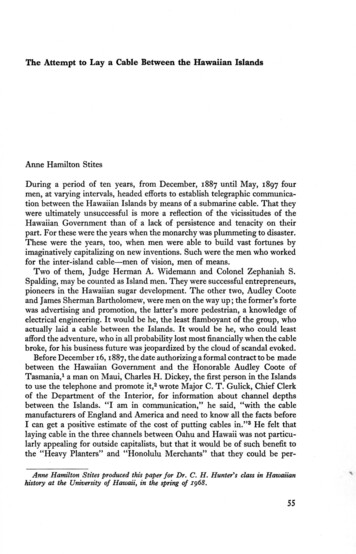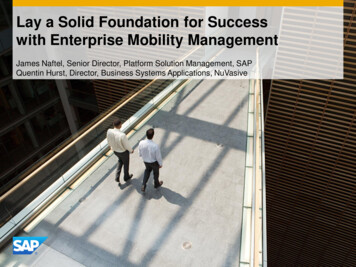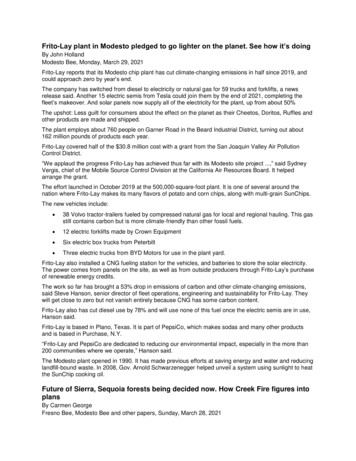
Transcription
The Attempt to Lay a Cable Between the Hawaiian IslandsAnne Hamilton StitesDuring a period of ten years, from December, 1887 until May, 1897 fourmen, at varying intervals, headed efforts to establish telegraphic communication between the Hawaiian Islands by means of a submarine cable. That theywere ultimately unsuccessful is more a reflection of the vicissitudes of theHawaiian Government than of a lack of persistence and tenacity on theirpart. For these were the years when the monarchy was plummeting to disaster.These were the years, too, when men were able to build vast fortunes byimaginatively capitalizing on new inventions. Such were the men who workedfor the inter-island cable—men of vision, men of means.Two of them, Judge Herman A. Widemann and Colonel Zephaniah S.Spalding, may be counted as Island men. They were successful entrepreneurs,pioneers in the Hawaiian sugar development. The other two, Audley Cooteand James Sherman Bartholomew, were men on the way up; the former's fortewas advertising and promotion, the latter's more pedestrian, a knowledge ofelectrical engineering. It would be he, the least flamboyant of the group, whoactually laid a cable between the Islands. It would be he, who could leastafford the adventure, who in all probability lost most financially when the cablebroke, for his business future was jeopardized by the cloud of scandal evoked.Before December 16, 1887, the date authorizing a formal contract to be madebetween the Hawaiian Government and the Honorable Audley Coote ofTasmania,1 a man on Maui, Charles H. Dickey, the first person in the Islandsto use the telephone and promote it,2 wrote Major C. T. Gulick, Chief Clerkof the Department of the Interior, for information about channel depthsbetween the Islands. "I am in communication," he said, "with the cablemanufacturers of England and America and need to know all the facts beforeI can get a positive estimate of the cost of putting cables in." 3 He felt thatlaying cable in the three channels between Oahu and Hawaii was not particularly appealing for outside capitalists, but that it would be of such benefit tothe "Heavy Planters" and "Honolulu Merchants" that they could be perAnne Hamilton Stites produced this paper for Dr. C. H. Hunter's class in Hawaiianhistory at the University of Hawaii, in the spring of 1968.55
suaded to donate at least three-fourths of the expenditure, which he estimatedwould be around 100,000. The Government could then make up the balance."I think it can be done. Whitney will work for it on Hawaii. I will work forit here. Will you work for it on Oahu?"4 He was evidently silenced forever,according to official records, by Gulick's formal reply that nothing was knownabout the depths of the channels.5 There was no hint of encouragement, adesire to cooperate, or an acknowledgment that here was a good idea.Unlike Dickey, however, Audley Coote was never silenced on his projectionsof things to be brought into being. His promotional effort in Hawaii startedabout 1878 with inquiries concerning the development of railroads.6 This wasfollowed up in 1880 by a bid to lay cables between the Islands, either on(1) a direct cash contract covering the manufacture, laying, and putting inworking condition of the cables before turning them over to the Government,or (2) an agreement to furnish the capital and maintain the line (with theGovernment paying interest for a number of years), reserving the privilegeto buy the cable at any time.7 Not receiving any invitation to follow up histentative offer, he evidently came to Hawaii anyway, and was fortunate enoughto have an audience with the King through the kindness of A. S. Cleghorn.This he mentions in a letter asking Cleghorn to put in a good word for himwith the Government about the possibility of laying a Pacific cable touchingthe shores of Hawaii—especially if Cyrus Field did not have an exclusiveconcession.8 And now he begins to get a nibble from no less a person thanW. M. Gibson, who within a few years would for all practical purposes haveusurped the power of government in the Islands.9 In all probability theircorrespondence, leading to the Act of 1884 for the encouragement of oceancables, knocked out the possibility of a binding contract being made with theHawaiian Cable Company, which had gone so far as to take soundings andmake a definite proposal to the Government for the laying of a cable betweenthe Islands.On February 13, 1882 Charles R. Bishop, John H. Paty, C. O. Berger, andH. A. Widemann filed a petition in the office of Minister of the Interior W. N.Armstrong, for a charter for the Hawaiian Cable Company. The stated purposeof the company was to lay ocean cables between the various islands of theHawaiian group, erecting telegraph lines, so that the Kingdom would havetelegraphic and telephonic communication. The amount of capital stock to beissued would be 200,000. Of those subscribing, Charles R. Bishop had thelargest amount.10 On March 20, 1882 the petition and draft of the charterwere presented to His Majesty in Privy Council by Armstrong.11 Mr. HenryM. Whitney moved to amend the charter by inserting a clause permitting theGovernment the privilege of buying the cable when in working order so thatit could be operated in connection with the Post Office. Mr. A. F. Judd movedits reference to a committee. So it was decided that he, Widemann andArmstrong would be the committee to iron out the rough spots. Interestinglyenough, on that same day, Armstrong signed the charter of incorporation ofThe Planters' Labor and Supply Company, one of whose charter memberswas Z. S. Spalding.1256
Before the Privy Council met again to consider the report concerning theapplication of the Hawaiian Cable Company for a charter, the Ministry ofGreen, Walker, and Armstrong was out, and the Ministry of Gibson, Kaai,Bush, and Preston in.13 But all that was accomplished at the meeting was theadoption of the report recommending the granting of the charter with certainamendments.14 The papers were then sent by Judd to the new Minister of theInterior, Simon K. Kaai on May 29.15 And that was that. Nothing more wasdone. On September 11, Berger, acting as manager for the hoped-for company,wrote expectantly that they were in the process of organizing, were evenready to take soundings. He wondered "how far and under what conditionsHis Majesty's Government will grant us pecuniary assistance?"16 There wasno answer.Two years later the company organizers tried again; rumors were aboutthat someone else was trying for a concession. The new Minister of theInterior, C. T. Gulick, was sent the original draft of the charter of the HawaiianCable Company, a copy of the report of the Privy Council, and a new draftof the charter with the suggested amendments.17 And this time there wasbetter fortune, though short-lived indeed; the company was granted the rightto incorporate on January 21, 1884.18 A few days before there had been editorialcomment—it was good to hear that the matter of cable communication betweenthe Islands was being taken in hand "with vigor" by the current Government.Three months before proposals had been received from abroad, and now theoriginal promoters had decided to have another go at it.19The charter was promptly accepted, and H. A. Widemann was chosenpresident; his son-in-law, C. O. Berger, secretary and treasurer; and H. R.Macfarlane, vice-president.20 Equally promptly Charles Gulick was asked byWidemann to submit the company's proposal of action and a tentative contractto His Majesty and His Cabinet. The Hawaiian Cable Company planned toestablish telegraphic and telephonic communication between the islands ofOahu, Molokai, Maui, and Hawaii, terminal points to be at Honolulu onOahu and at Hilo on Hawaii. After this had been accomplished the companywanted the exclusive right to carry out further communication, not only withinthe Kingdom, but with foreign countries. It was expected that the Governmentwould grant a certain sum of money to aid the enterprise, after which nomore would be expected. Widemann concluded with the promise: "Thecompany agrees to commence operations immediately upon execution of thecontract. . . ." 21At the same time W. D. Alexander, Surveyor General, was asked to furnisha man from his department to help the company take the necessary soundingswith the understanding that once on the job he would be on their payroll andsubject to their orders.22 Alexander was delighted at the prospect of obtainingsuch information as would be discovered for his own records and those ofother scientific men, and in writing Gulick, who he felt would be the properperson to answer for the department, he suggested that the condition forgiving assistance should be that both results of the work and the record of suchwork should be deposited in his office.23 Thus, Gulick replied to both Wide-57
mann and Berger in the same letter, letting them know that before anydefinite contract could be entered into by the Government, "careful soundingsand surveys of the ocean bed to be crossed by the contemplated cable willhave to be made and prepared," and that duplicates of the work should befiled at the office of the Surveyor General. Captain George E. G. Jackson hadbeen assigned to help them, and it would be possible for the Government togive some financial help.24In reply Berger sent an estimate of the anticipated expenses, asking for agrant of io,ooo.25 And on March 3, 1884 he was able to report that the sounding party aboard the W. H. Reed had completed work in the Hawaii-MauiChannels and was working in the Molokai Channel, and that since expenseshad only amounted to 6000, he would like permission to go ahead and do theKauai Channel, which had not been bargained for.26 He was told to proceed,and the Kauai soundings were evidently taken.27 From then on there was badnews. The new attorney general, Paul Neumann, had turned down the offermade by the Hawaiian Cable Company before it set out on its soundings.28The message was relayed to H. A. Widemann that his offer was declinedbecause the department "deems it impolitic to bind the Government to acontract which is left to the option of the other party, no matter how short atime such option may be granted."29 In August the company was requestedto send vouchers for the 6800 they had received from the Government tocarry out the soundings, and to hand over the charts. But the records kept byCaptain Jackson were not obtained until 1886.30It is only by examining the Gibson-Coote correspondence that this treatment of a local company already in the field can be understood. From themoment Gibson responded in December, 1882 to Coote's overtures, theeventual outcome could practically be predicted. With each successive letterwas an offer; Coote was determined to hit the jackpot. After the King's speechopening the Legislative Assembly of 1884, in which he had said that bothinter-island and trans-oceanic cables would be submitted for consideration"as a national Hawaiian enterprise," Coote came up with the names of the"influential gentlemen" for whom he was acting: the Duke of Manchester,Sir Julius Vogel, Sir Charles Bright, John Muirhead of Latimer Clarke,Muirhead & Company, Ltd., the Hon. Howard Spensley, and the Chairmanof the British India Steam Company.31 These men were willing to negotiateconcerning the laying of a cable between Hawaii and San Francisco and Hawaiiand Australia as well as connecting up the various islands. However, sincethey were trying to get concessions from the various governments, it was vitalto keep the matter confidential. And another thing: If the Hawaiian Government wanted to keep island communication in their own hands, this workcould be handled separately for a stated sum.32 Evidently it was the namedropping that determined Gibson's next moves, for he was now convincedthat Coote could follow through on his grand schemes. But how was he topersuade the Legislature, since the matter of appropriations had become avery touchy subject?58
On August 7 Gibson asked not for money, but that the Government begiven the right to make arrangements with the Australasian Cable Syndicate,a group working out plans to lay a Pacific cable. Certainly Hawaii did notwant to miss inclusion in something that would help the business community.Also, the Syndicate would lay an inter-island cable. As the Minister of Financehad said earlier, no funds should be granted in the current session to aid telegraphic communication. Nor should any future amounts be put to such apurpose that were not "commensurate with the resources of the Kingdom."Certainly, the offer was at the moment far too high for the Government toeven consider, but with more talks and power to act, this could be handled toHawaii's advantage.33 This was considered by a special committee, whichrecommended that an act be passed stipulating an amount that the Legislaturethought would not be a strain on the revenue, and that the Government begiven permission to communicate officially with the Syndicate.34 The resultwas Act LXI, authorizing the payment of 20,000 for a period of 15 years toanyone establishing telegraphic communication between Honolulu and SanFrancisco.35 The King spoke of his pleasure at the favorable outcome of theAssembly's deliberations on ocean telegraphy.36 Coote was pleased, too.37Others besides Coote were interested in cooperating with the HawaiianGovernment. Abraham Hoffnung wrote Gibson on July 5, 1886 that a Mr.H. R. Armstrong would be coming to the Islands "with several importantobjects in view."38 Not only was Mr. Armstrong, a partner in the firm ofSkinner & Company, London, planning to lay the groundwork with Gibsonfor a national loan act, but was prepared "to negotiate and conclude an agreement with the Telegraph Construction and Maintenance Company, Ltd. ofLondon for the delivery and laying of submarine cables to connect in telegraphic communication such Islands of the Kingdom for which communicationmay be desired."39 To substantiate this Armstrong had a letter of verificationwith him containing the definite offer of Admiral George Henry Richards,managing director of the London telegraphic firm. Both an inter-island systemand a connection with North America would be attempted if the HawaiianGovernment would agree to certain conditions. The cables were to be laidat the company's expense but to be operated at Government expense. Thecompany was to be granted a subsidy of 1,500 pounds for a period of 25 yearsafter the opening of the line. For having established telegraphic communicationbetween the Islands the company wanted the exclusive right to land cableson any of them from any part of the world for five years. When communicationwas completed between Hawaii and North America the right was to be extended for 40 years. The Islands would be connected up within fifteen months ofthe signing of the agreement.40But much had to be done before Gibson could act on this proposition. FromJuly, 1886 to July, 1887 he and Kalakaua would be playing musical chairswith the Cabinet, trying every possible maneuver for the necessary authorityto float a national loan. They were finally successful, but there was a stipulation; it was necessary "to define the uses to which the money borrowed shallbe applied."41 The Act was passed on September 1, 1886. The sum of59
250,000 had been earmarked for inter-island cable communication.42 Thiswas not the final word, for on October 6 there was an amendment. Only 100,000 was set aside, the amount to be used for electric light in Honoluluand for the inter-island cable.43Armstrong in the meantime had returned to England to raise money for theloan. Gibson asked him to make contracts for lighting the city of Honoluluas well as for the cable.44 These plans were stymied because of the great changesof 1887 in the Hawaiian Government. A few months before the GreenThurston Ministry took over, Armstrong wrote to Luther Aholo, Minister ofthe Interior, that Audley Coote had contacted him, thinking that the 100,000appropriated in the Loan Act would be readily available. Coote proposed threealternatives for joining four islands of the Hawaiian group, omitting Kauai,by telegraphic cable: (1) a cash payment, (2) a subsidy, (3) a guarantee of acertain amount of interest upon the cost of the cable. And though Armstrong,who had been made Consul General for Hawaii in England, acted in his officialposition to discourage Coote, he still passed the offer on to the Government,not knowing the exact conditions in the Islands.45 Armstrong was told he hadacted correctly and that a trans-ocean cable would be pushed first.46Plans were under way to form a company "to raise money for buying, laying,constructing, and maintaining telegraphic cable communication between theHawaiian Islands and the coast of California in the United States of America,and also between the Hawaiian Islands and the Empire of Japan."47 WilliamG. Irwin, Henry F. Glade, Peter C. Jones, Herman A. Widemann, and JamesCampbell filed a petition for the Pacific Cable Company, which would have acapital stock of 1,000,000, three-fourths having been subscribed for, thelargest number of shares, 5,500, being under the name of Cecil Brown,"Trustee." 48 A charter was granted them on July 3, 1889 and accepted onAugust 27, 1889. A. S. Hartwell, a Harvard man, was made president; CecilBrown, vice-president; W. O. Smith, secretary; P. C. Jones, treasurer; C. R.Bishop, auditor.49 Hartwell, in the meantime, had asked Lorrin A. Thurston,the new Minister of the Interior, for an exclusive franchise, to which Thurstonreplied that the "prime object" was to obtain cable communication withNorth America, and the Government was not going to tie itself up in any wayto prevent anyone from accomplishing this goal. Furthermore, there was stillin existence the exclusive privilege granted in 1887 to Audley Coote, whichcould not be canceled if Coote were able to provide "assurances that the cableshall be laid not later than August 1, 1890 from some point on the NorthAmerica continent to the Hawaiian Islands."50 During November, 1889 theCabinet met informally with a committee from the Pacific Cable Companyconcerning the Government guarantee the company hoped to obtain on theinterest to be given on the bonds issued.51 At one of these meetings a charterwas granted the Hawaiian Pacific Cable Company.52 This was the only firmthat succeeded in laying cable between the Islands.In July, 1888 James Sherman Bartholomew signed a contract with the Government granting "the sole and exclusive right and privilege" for the construction,laying, and maintaining of a submarine electric telegraph cable to connect60
Hawaii to Kauai by a line running from Hawaii to Maui, from Maui to Oahuwith a landing on Molokai, and from Oahu to Kauai. Payment of 8000 wouldbe made when the system was working between Oahu and Maui; another 8000 for the connection in working order between Oahu and Hawaii; 9000upon completion between Oahu and Kauai in working condition. Armed withthis agreement, Bartholomew proceeded with his partner Edgar Crow Bakerof Victoria, British Columbia to order all of the materials necessary for theventure.53Evidently their mutual telegraphic interests had brought these two mentogether. Bartholomew had his degree as an electrical and telegraphic engineerfrom the New York Electrical College in Poughkeepsie. He had been treasurerand then assistant superintendent of Pullman's Pacific Car Company. Laterhe became manager of the Burlington Route Telegraphs at Omaha, Nebraska,and officer in charge of a U.S. Signal Station. His relative, Charles Bartholomew, had been in charge of the Atlantic Cable Station at Trinity Bay, Irelandduring the cable laying of 1858.54Baker had been a lieutenant in H.B.M.'s Navy for eighteen years. Afterretirement he went to the province of British Columbia and was most influential in gaining its admission to the Canadian Domi
Kauai Channel, which had not been bargained for.26 He was told to proceed, and the Kauai soundings were evidently taken.27 From then on there was bad news. The new attorney general, Paul Neumann, had turned down the offer made by the Hawaiian Cab











